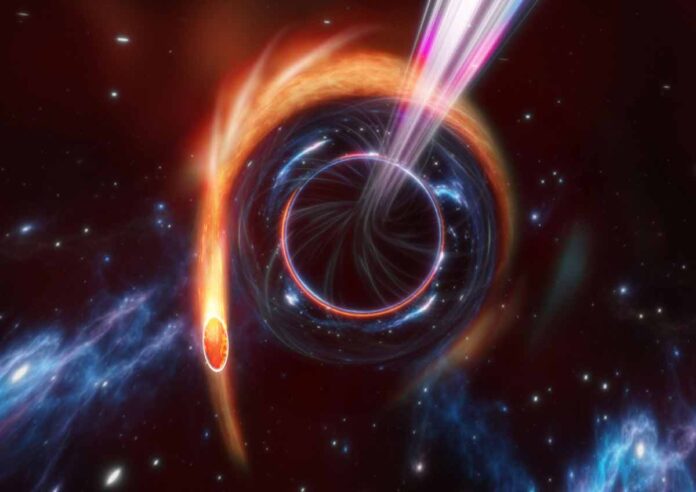Astronomers have discovered the source of an extremely bright X-ray, optical, and radio signal seen halfway across the Universe.
The signal is known as AT 2022cmc. It was discovered earlier this year by the Zwicky Transient Facility in California. The findings was published in Nature Astronomy on November 30. It is most likely from a jet of matter streaking out from a supermassive black hole at close to the speed of light.
The team was led by researchers from NASA, Caltech, and other institutions. They published their discovery in an astronomy newsletter. There the signal drew the attention of astronomers from all over the world, including MIT scientists. Several telescopes focused on the signal over the next few days. It gathered more data across multiple wavelengths in the X-ray, ultraviolet, optical, and radio bands to determine what could possibly produce such an enormous amount of light.
The MIT astronomers and their collaborators have now identified a possible source for the signal. The scientists report in Nature Astronomy that the signal is dubbed AT 2022cmc. It is most likely the result of a relativistic jet of matter streaking out from a supermassive black hole at close to the speed of light. They believe the jet is the result of a black hole devouring a nearby star and releasing a massive amount of energy in the process.
Other “tidal disruption events,” or TDEs, have been observed. There a passing star is ripped apart by the tidal forces of a black hole. AT 2022cmc is the brightest TDE discovered to date. At 8.5 billion light years away, the source is also the most distant TDE ever detected.
How could such a faraway event be so bright in our sky?
According to the researchers, the black hole’s jet could be pointing directly at Earth. It made the signal appear brighter than if the jet was pointing in any other direction. The effect is known as “Doppler boosting,” and it sounds similar to an amplified siren.
AT 2022cmc is the fourth Doppler-boosted TDE ever discovered, and the first such event since 2011. It is also the first TDE discovered with the help of an optical sky survey.
Frenzied feeding
Following the initial discovery of AT 2022cmc, scientists narrowed in on the signal using the Neutron star Interior Composition ExploreR (NICER), an X-ray telescope aboard the International Space Station.
Such bright flashes in the sky are typically gamma-ray bursts. These are extreme jets of X-ray emissions emitted by the collapse of massive stars.
The team then collected data from other X-ray, radio, optical, and ultraviolet telescopes and tracked the signal’s activity over the next few weeks. The signal’s extreme luminosity in the X-ray band was the most remarkable property they discovered. They discovered that the X-ray emissions from AT 2022cmc fluctuated by a factor of 500 over a few weeks. They suspected that such extreme X-ray activity was caused by an “extreme accretion episode”. It is an event that generates a massive churning disc, such as a tidal disruption event. There a shredded star creates a whirlpool of debris as it falls into a black hole.
The team discovered that the X-ray luminosity of AT 2022cmc was comparable to three previously discovered TDEs. These bright events resulted in matter jets pointing directly at Earth. If AT 2022cmc’s luminosity is caused by a similar Earth-targeting jet, how fast must the jet be moving to produce such a bright signal? Scientists modelled the data from the signal, assuming the event involved a jet flying straight toward Earth.

